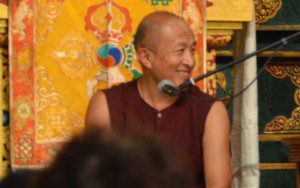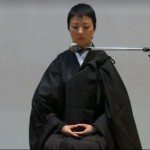
In a long (4000+ word) post on facebook yesterday, the Buddhist teacher and filmmaker, well known for his wit and sense of humor, speaks about the need for reform in the system of reincarnated teachers in Tibetan Buddhism known as tulkus.
Titled “Time for radical change in how we raise our tulkus,” the document has eight sections. Excerpted here are those sections with key points and quotations.
The document itself was prompted by the choice of Jamgon Kongtrul Rinpoche to leave his role as a tulku, writing, “with a difficult heart, I have chosen a different lifestyle and will study and pursue my dreams of becoming a doctor.” The young tulku wrote, further:
Now I have reached a state where it’s unbearable, I have been restricted to fulfill my dreams and have not been allowed to take responsibility and stay in peace and I feel I am a burden to all.
I have made this choice as the last resort and I had tried every possibilities to avoids this choice but now I am tired of all these problems repeating and them using the same excuse over and over again! I doubt you all will understand my choice but I hope you do.
Dzongsar Khyentse follows his mention of this event by comparing the life of the tulku in his day, which consisted of a list of deprivations, “eating nothing but rice and potatoes for up to a year, travelling on India’s cheapest public transportation, sleeping on railway platforms, having no more than 10 rupees in our pockets for six or seven months.” By comparison, he writes, “our present generation of tulkus is utterly spoiled and has the easiest ride.”
However, Dzongsar Khyentse recognizes that life is still not easy for the contemporary tulku and that current conditions in some ways are much worse. They live in a faster paced world with a brighter spotlight (read Dzongsar Khyentse’s Social Media Code of Conduct), meaning a reassessment of the tulku system and training is in order.
Why our young tulkus need training
Here Khyentse explains that tulkus, while believed to be reincarnations of a previous master, still need to be brought up in the fundamentals of life in the contemporary world. They may possess lifetimes of spiritual knowledge, but, “Moving from one life to the next is not like moving from one room to another. There have been tremendous changes over time, which require new forms of training if tulkus are to manifest their true nature and qualities. Blind student adoration, often arising from cultural preconceptions, conceals from us the need to re-examine the training these young tulkus actually need.”
He notes that this applies to those who are “genuine reincarnations” as opposed to those who may have been given the title for different reasons. In either case, he concludes, good training is needed.
Fundamental flaws in current pedagogy
Khyentse follows here with more specific problems – including those of the past that have been remedied over time, “if merely because teachers could today go to prison for the way they used to raise us. There may be no beatings today, and there may even be weekend holidays, plenty of family visits, and lots of toys.”
However, turning again to the way that Tibetan Buddhism, and with it the young tulkus, has been thrown into the international spotlight, Khyentse says that the expectations of so many people becomes a pressure like no other. This, he says, can make tulkus, “end up isolated and imprisoned in one of the loneliest and most alienating zones imaginable.”
Misguided focus on image and wealth – a formula for pressure
Khyentse here notes the “world’s growing materialism and affluence” which have “found their way into our monasteries” and the lives of young tulkus. Countering this he proposes no radical asceticism, but rather modes proposals such as re-examining Tibetan Buddhist behavior during winter gatherings in Bodhgaya, a site holy to Buddhists from around the world.
“I often wonder what other Buddhists, like the Theravada practitioners, think of our lamas sitting on thrones that may even be higher than some of the Buddha statues.” Bodhgaya, he continues, “would be a good place for our lamas to start practicing simplicity and humility!”
“In short, besides inadvertently turning our young tulkus into spoiled brats, the current focus on wealth and privilege as part of tulku training is anathema to Buddhist pedagogy and its core values.”
The prison of privilege
Tulkus can become “attractions” at monasteries, used to attract practitioners and thus coming to be seen as “assets to monasteries.” The titles and adoration come without responsibility. “With so much wealth, privilege, and adoration as the prize, it’s no wonder we now find so many parents eager to have their kids enthroned as one high lama or another. Little do they know how much their children will suffer.”
This suffering, Khyentse writes, comes from their lack of normal human development, including the trials of dealing with hormones and other worldly realities.
Breeding ground for hypocrisy
This mixture of outer adoration and inner suffering leads to various types of hypocrisy, including the imposition of celibacy on them from a young age. Khyentse points out that it is not permissible to impose this on another person and that even the Buddha only became a renunciant -by choice- after having a wife and child.
Pedagogy for today’s world and for the future
This is where Khyentse’s writing becomes clearly prescriptive, pointing out concretely what needs to happen next, from the basics of sharing to more complex activities. “When they are served and offered everything, many of these tulkus never learn even the simple human knowledge of sharing, and end up ill-equipped to live in the world. They not only need leadership training, but need a basic course in human relationship.”
Just regular child rearing skills are often missing in monasteries, a fact that should be remedied in the years to come. Secondly, a reverence for the teachings -and elder teachers- seems to have been lost of late (again, in the place of superficial ceremonies and high thrones and attracting the faithful).
Social and cultural barriers to a genuine tulku training pedagogy
Here Khyentse writes that “a large reason for the situation can be attributed to traditional societies like the Tibetan and Bhutanese, which are a complex mixture of heartfelt devotion and outdated cultural baggage.”
“There’s even an eastern Tibetan saying that was used to scold me when I was growing up, that lamas should be like a gold statue – meaning we should sit very still, not look right or left, and act more like a precious object than a human being. There’s another saying that a snow lion must remain as a snow lion in the high mountains, because if he comes down to the ground, he will be mistaken for a dog.
These two idioms really say it all, revealing not only how lamas are actively discouraged from mingling with ordinary people but also how obsolete is our traditional pedagogy for raising lamas for a contemporary society.”
In opposition to this, Khyentse suggests that lamas (teachers) need to become aware of contemporary society, with its particular forms of suffering. This way he (or rarely she) can better teach those who are suffering and he can understand the need to change or look past the superficial aspects of the tradition.
Stuck in a time warp
Khyentse suggests that the training system of today is stuck in the 1930s or 1940s, out of touch with the realities of the 21st century. This is a systemic problem that results in tulkus having needlessly difficult lives.
Aspiration for our upcoming tulkus
Finally, Khyentse offers praise for Jamgon Kongtrul’s decision insofar as it could serve the survival of the tradition in ways that a tulku in monks robes could not. In fact, he says that he instructs teachers and friends not to encourage non-Tibetans to wear Tibetan clothes. Seeing Buddhists “in army uniform, suit and tie, or other normal dress sends the message that Buddhism can be practised by everyone.”
The dressing up of converts in Tibetan clothing he identifies with “a cultish atmosphere” and describes it as “introverted exclusivism.”
Read the full post here.












